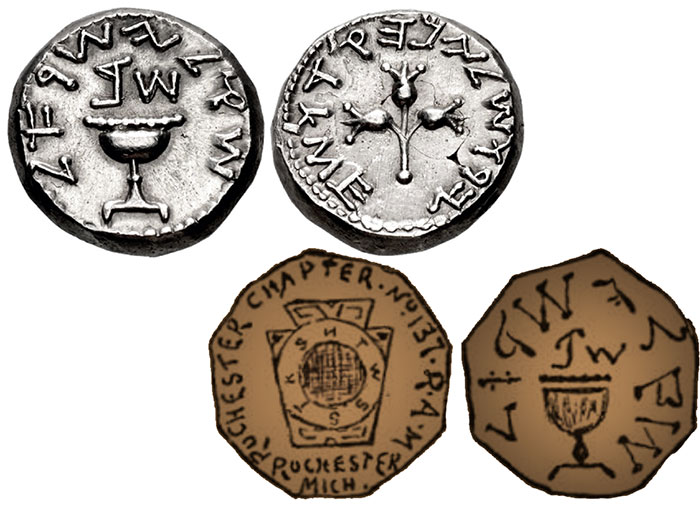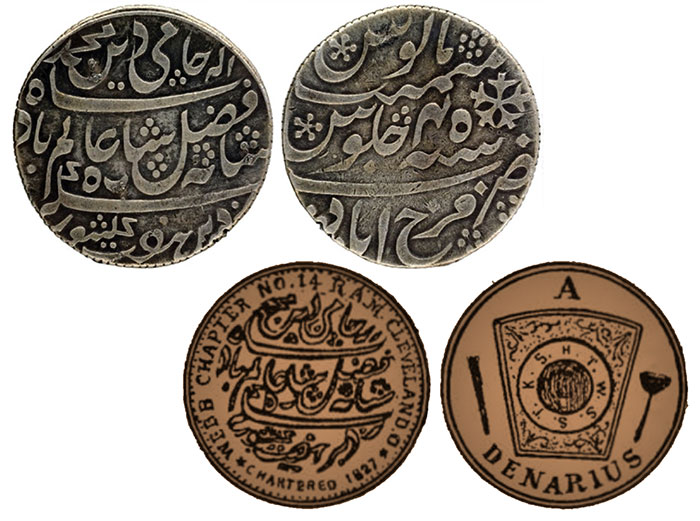The Magpie Mason is an obscure journalist in the Craft who writes, with occasional flashes of superficial cleverness, about Freemasonry’s current events and history; literature and art; philosophy and pipe smoking. He is a Past Master of both The American Lodge of Research in New York City and of New Jersey Lodge of Masonic Research and Education 1786; and also is at labor in Virginia’s Civil War Lodge of Research 1865. He is a past president of the lamented Masonic Society as well.






The Wasserman family announced today on social media that James Wasserman had died November 18 after a long illness. Funeral arrangements are being made.
While I know nothing of O.T.O. nor of his writings on that subject, Wasserman also wrote books of interest to Freemasons, and he was a friend to the Livingston Library, and was an engaging speaker to Masonic audiences. I do not know if he was a Brother Mason. R.I.P.
CoinWeek, an online periodical devoted to numismatics, occasionally addresses topics orbiting Freemasonry in articles about Masonic persons, places, and things commemorated on U.S. money. Last Friday though, it ran a piece not on coins or cash, but on a facet of exonumia well known to Mark Masons: the Mark Penny.
I recommend the article for the art that accompanies the text, because most of Tyler Rossi’s reporting is annoyingly bad. We can pardon the outsider’s nescience with our jargon, but it also sounds like he wants to misrepresent, such as when he claims the Craft has “a vitriolic opposition to the Roman Catholic Church.” He does cite sources, listing seven references in a bibliography, but he could have done better.
The value of this article is based mostly on the research delivered in Masonic Chapter Pennies (Vols. 1&2) by Dr. B.P. Wright from 1903 (a reprint from the July 1901 edition of The Numismatist). From there, I suppose, it is impossible to materially err.
Anyway, the article shares some exotic variations on the Mark Penny. Great, because if you’re like me, you know only the commonplace coinage from catalogs.
I’m rambling when I need only provide the link. Read all about it here.
 |
| Courtesy CoinWeek |
 |
| Courtesy CoinWeek |
The Masonic Temple in Philadelphia, headquarters of the Grand Lodge of Pennsylvania, has been ordered closed through the end of the year by the city government.
At a press conference Monday, Mayor Jim Kenney and Health Commissioner Thomas Farley announced a list of precautionary measures for managing the pandemic, including a city-wide ban on indoor gatherings and events, whether public or private. The order was made effective to January 1 to permit time for desired benefits of the lockdown to materialize, because a vaccine will not be available until January, and because it is thought the spread of the virus will not abate until winter arrives. It is possible the ban on gatherings may be extended.
The list of varying prohibitions also affects businesses, schools, religious sites, museums, libraries, and other destinations.
The Grand Lodge announced the closure through its social media accounts after the mayor’s press conference.
I’ve never been, but I figure Oklahoma must be a special place since its flag depicts a smoking pipe among its symbolism. Now I know the Grand Lodge there imparts a special Freemasonry to the world, because yesterday Bro. Robert G. Davis was installed Most Worshipful Grand Master of Masons.
Congratulations, Bob!
Actually, congratulations to the brethren of Oklahoma! It is not common for a brother who you want to ascend to the top to do so. The kind of Mason who authors essential books and who lectures thoughtfully on the meaning of Masonry typically does not seek high profile office, but that is what happened here.
Who says 2020 is a bust?
I wish you a productive year unhindered by quarantine, inclemencies, smoking bans, or other troubles.
I first “met” Bob about 20 years ago in the Masonic Light group, and met him for real at the 2002 AMD Weekend in the Hotel Washington in DC. Ah, you could smoke at the lobby bar then. I noticed Bob enjoyed Hoyo Excalibur IIIs, a preferred cigar of mine as well. (I don’t know why I keep bringing up smoking. It’s just past noon here, so it’s time for a pipe.)
Bob, God bless! I’m sorry Masonic Week won’t happen in February, but I look forward to shaking your hand again soon.
I just learned the 2020 Sankey Lecture, postponed in March, is rescheduled for...Sunday! Free and online.
W. Kirk MacNulty, the renowned Masonic author, died Sunday, according to Shawn Eyer, who disclosed the sad news on Facebook. He was 88.
To read his books is to cherish them: The Way of the Craftsman (1988), Freemasonry: A Journey Through Ritual and Symbol (1991), and Freemasonry: Symbols, Secrets, Significance (2006).
MacNulty was made a Mason in 1961 in Carson Valley Lodge in Nevada, and subsequently affiliated with lodges in England, Hawaii, Tennessee, Virginia, and Washington, DC. He served in the East of Lodge of Living Stones 4957 in England three times, and was the Charter Master of Lodge of Nine Muses 1776 in DC in 1997.
“Few brothers have done more for the speculative mission of the Craft in recent times,” Eyer writes. “When he wrote The Way of the Craftsman in the 1980s, he helped midwife the renaissance in Masonic philosophy that we are all now enjoying.”
Alas, my brother.
An online magazine devoted to Freemasons in New York went live Wednesday night. Craftsmen Online is an independent labor coordinated by Bro. Steven Rubin (he is the Right Worshipful Grand Treasurer of the Grand Lodge as well). Rubin says:
I am extremely excited to introduce Craftsmen Online, a website started by New York Brothers for New York Brothers. This is not an official Grand Lodge site, but simply a means to connect Brothers, and to champion everything that is special about Freemasonry in New York.
For those wishing to locate my “Buildings and Lodges 101” series, those recordings and material for each program will be posted on this site.
We also will post other lectures and blogs of interest to members of the Craft. Within the site, we will highlight New York Brothers who are Craftsmen—Craftsmen who are craftsmen—in our monthly spotlight on operative Brothers, their businesses, crafts and Masonic connections.
We will further explore the many historic Masonic locations and places within the State of New York.
Within our segment titled Masonic Ink, every month we will profile a new Brother to learn how Masonic symbols become works of modern art.
This is only the beginning, and I am asking for your help. If you want to be involved in this new venture, we are looking for storytellers, connectors within our Lodges, and Brothers with talents from photography to graphic design. Or if you simply know a Brother, person, place, or event whose story should be told, we value that contribution as well.
Under Masonic Education, the first issue gives us W. Bro. Galen Kaback, Master of Service Mizpah Lodge 586, who discusses special meanings embedded in the lodge opening and closing rituals. The Masonic History page offers insight into how the Utica Temple’s museum came about.
The Craftsmen feature tells the story of W. Bro. Nathan Davis of Cobleskill 394, who makes briar pipes for our smoking pleasure, and he also is a distributor of Kaywoodies.
Masonic Ink introduces us to W. Bro. Jason Chaplin of Mount Zion Lodge 311 in Troy, who sports a variety of tattoos you’ll want to see. He truly is the illustrated Mason!
This well written and designed website has a lot more thus far. Check it out. It is dedicated to “Connecting New York Freemasons,” as it reads on the homepage. New York is a huge, bustling, and growing Masonic jurisdiction, and I think we all benefit from having a variety of media sources—and the more independent, the better—to find each other. The Editor-in-Chief is Bro. Michael Arce. Bro. Anthony Dicarro is another editor. I congratulate them and whoever else is on the team. Keep up the great work, and thank you!
New York Freemasonry was among the parties interested in real estate previously used as a Roman Catholic seminary, before the diocese withdrew the property from the market while it works on its bankruptcy filing, according to a story published this morning in The Buffalo News.
Specifically, it’s the Masonic Hall and Asylum Fund, the Grand Lodge of New York’s corporation that owns and operates the fraternity’s real properties, including the Masonic Care Community of New York, the 320-bed health care residence in Utica.
Masonic representatives expressed interest in the 117-acre Christ the King Seminary property, located in Aurora, in August.
It was last November when the Masonic Hall and Asylum Fund, purchased the 16 acres of the former College of New Rochelle, at a cost of $32 million, to expand the health care services provided at the Utica campus to the New York City area.

 |
| Michael LaRocco |
Copyright © 2008-25. All rights reserved. No part of this website (text, graphics, sounds or images) may be copied, reproduced, distributed, republished, downloaded, displayed, posted, or transmitted in any form or by any means, including, but not limited to, electronic, mechanical, photocopying, recording, mirroring, or otherwise, without the prior express written permission of the copyright holder, who can be reached by leaving a note in the comments section.
If you are stealing content from this website, you ought to stop and consider who you are and what you are doing.